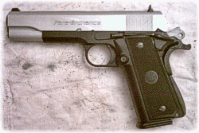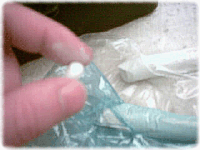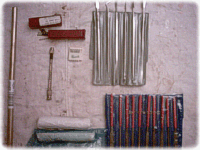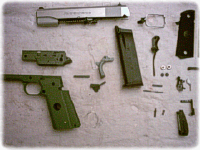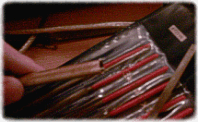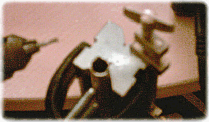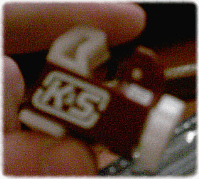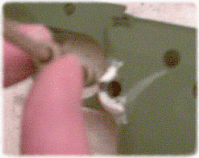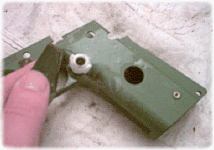The Western Arms Para Ordinance P14.45... I love the lines of the 1911s and the double stacker was my first choice for a sidearm. I've used my P14 as my primary skirmish sidearm for as long as I've been playing (and as my primary on occasion) but it's cost me. G.B.B.s will always cost of course, gas and BBs cost money and upgrades are always a tempting prospect but that's not the cost I'm referring to. My P14 has cost me one hundred and twenty pounds so far in lost magazines. The first I lost when the pistol leapt from the thigh rig during my first game, the rig had come loose from my belt and was bouncing off my knee cop at the time. I spent a few hours that night stitching the belt loop up so tightly that wild horses couldn't undo it. I lost the second two weeks later and, having lost one, decided to spend the lunch break looking for it rather than waiting for winter - when the undergrowth would have died back and would make it easier to spot. I found it, but only because I trod on it. I came close to loosing magazines on several other occasions, but noticed them before I left the position... Until my first game at Fireball. Somewhere on that site I lost yet another pistol magazine. I resolved to do something about these lost magazines, I couldn't afford to keep replacing them. Every time I'd nearly lost magazines they'd simply slipped out, shock loading might be wrenching some of them out (a full Para Ordinance magazine is quite heavy after all) but for them to slip out as I crouched or knelt there would have to be something else. My thigh rig is WebTex, made from very stiff cordura and worn on my right leg... Others in my team had dropped magazines from other pistols simply by picking them up too quickly because their fingers - in wrapping round the pistol grip - caught the magazine release. That might well be it I thought, stiff as the thigh rig is it will still deform when I squat and looking at the pistol there was the magazine release, standing proud behind the base of the trigger guard. If I put a guard around that, small enough that the cordura wouldn't deform into it but my thumb would I might solve the problem. I'd just fitted a metal slide and fallen in love with the naked aluminium so I already had plans to airbrush the frame as soon as I could find a paint with the right finish that wouldn't wear off at the slightest touch. I filed the idea therefore, deciding to make the modification at the same time as I resprayed the frame. I taped the magazine in for several skirmishes, only having one now the ability to change clips quickly wasn't really an issue. Then my Krylon paint arrived. Before I go any further I must apologise for the quality of the photos, my camera isn't great and has real problems focussing at ranges of less than a few feet, they looked OK on the inch square screen on the camera but… Materials: Cylindrical Brass tube 3/8" Diameter, Hard Epoxy Putty (I used Milliput Superfine white because it's what I had but Fine Yellow Grey, Kneadatite Brown/Aluminium or any of the hard putties should do the job just as well, even car body filler should though it's larger grained and more difficult to work with). A note on Epoxy putties: Like all epoxy these putties come in two parts which are mixed as and when you need them, until they're mixed they don't harden. However over time the constituents oxidise and go off, storing them in the freezer will extend their life considerably but even then the surface putty will become less and less useful. My putty was a little old and my first mix was a little hard and took a long time to cure, I took the second mix from the below the surface of the sticks with much better results.
The olive drab parts would all be painted and so were carefully washed to get rid of any lube and air dried. The metal rear frame, safety, beavertail and that little tube between the slide release and the safety all needed painting but weren't required for the modification so they were then set aside, hung or glued to the hooks which would support them as I sprayed them and would be sprayed during the "downtime" while I was waiting for things to cure. My spray booth was built for much smaller parts so the front frame would have to be painted separately anyway. That done I needed to wait for it to cure. The spare putty I'd mixed up would allow me to check how it was going without touching the putty on the gun, they were both moved a little closer to the heater (although I didn't trust them to my putty oven - and they wouldn't have fitted anyway. Epoxies cure more quickly when they're warm). While I was waiting I moved on to the brass, brass isn't hideously strong but the size of the part and the putty that would cover it meant this wasn't much of a concern, brass tubing was cheap and convenient. The tube was clamped into a vee block so that I could work on the end easily, unfortunately I don't have a vice large enough to hold them at the moment so I clamped block straight to the table with a small sash clamp. Using a small metal burr and my power drill I set to. The aim was to make three spikes at the end of the tube and while I would finish them with a file the amount of metal I needed to remove meant that the burr was the better option at this stage. The material removed was a rough cut, taking out the bulk of the material but leaving plenty to finish with the file (and to avoid any "mishaps", accidentally removing too much material for example). It is vital that you wear eye protection when doing this. Time for a cup of tea. While I was at it I sprayed the other frame parts and checked my favourite web forum (Well what other forum am I going to mention?) until the putty on the frame had cured and I was able to continue. I decided to mark the frame up agriculturally rather than getting the marking blue out as by now it was getting a little late and I wanted to get the next lot of putty on so that it could cure over night. To that end I placed the ring, spikes down, on the frame - orienting it so that two of the three spikes would be in the existing frame. I used a scalpel to scribe the positions of each spike and flipped the ring over to mark the PCD, I used the scalpel because my scriber is somewhat blunt at present and it would give nice narrow, shallow cuts which would also key the putty in quite nicely. Next step was to find an appropriately sized drill, because I have a selection of small drills together in one pot I can't tell you what size it was but I'd guess at around 1/32", and using my Archimedes drill (Power tools, even my mini power drill or a dremel can't be trusted with small gauge drills like this, the slightest snatch and they break them; although this drill was at the top limit of the Archimedes drill's chuck) The two holes marked on the original frame I drilled through, that marked on my modification had a lot of material below it so I only took it down about 6mm. The two through holes were then cleaned up on the inside with the scalpel. Next job was to file down one of the spikes, the upper of the two that would sit in the original frame was too long at present and would, if left that way, interfere with the trigger mechanism. It only needed a couple of mm taken off and with that done I checked it by dry fitting it with the frame before adding a tiny amount of superglue to all of the contact faces and finally fitting it in place. Out came the putty again (this time taking it from below the oxidised surface and suddenly realising how bad the previous batch had been, this was much softer and stickier) and this time I made up two large mung bean sized blobs, giving me a pea sized blob to work with. First step was to pack putty around the inside and outside of the brass ring, if I'd left any gaps which could cause weakness the putty would fill them. I then built the level up inside the ring, ensuring that I reduced the hole size as a guarantee of coverage added a strip to the edge of the ring and then the outside. The wax carvers then came out to work that outer putty into a bevel and trim the inner putty back a little, again bevelling it and trying not to remove the bridge of putty which joined the inner and outer. Once I was happy with that I put the final spray on the other frame pieces and went to bed. The next morning I had work... Now for the moment of truth. I fitted the magazine release button back into the frame. Looking across the edges of the ring I realised I'd taken just a little too much material off, the top of the button was just visible. I put the magazine in and pushed lightly on the magazine release, just until I could feel the ring start to press, nothing. I shook the frame over my armourer's mat, still maintaining the pressure, nothing. Okay, doesn't seem too bad. Now came the time to see whether I could still release the magazine when I wanted to, pushing my thumb into the ring in the way I would do when changing I was relieved to see the magazine slide neatly out. There wasn't much leeway but it worked. Because of this small leeway I decided against building the ring up to totally hide the button, that and I wanted to get the thing sprayed and back together so that I could see what it looked like. Finally I got the wet and dry paper out and polished everything up, tidied the fillets...etc. and blended the putty into the frame. This was perhaps the longest part of the operation, taking almost an hour before I was happy with it, not because I was removing a lot of material but because it had to blend so neatly. Any defect here would show up horribly when the frame was painted and here they were disguised but the colour change between frame and putty. I almost forgot to remove the magazine release again before doing this, though I wouldn't have been able to polish the inside bevel if it had still been there so it's not easy to forget. While I was at it I cleaned up the mould lines on the inside of the trigger guard, first with a file, then the edge of my scalpel and finally with the wet and dry. Once everything was as smooth as the proverbial baby's bottom I washed the frame down again to remove any dust or contaminants and superglued a partially opened paper clip into the magwell to hang the frame by. The Krylon came out again and the frame received the treatment... Two and a half hours later (as I was going to be sliding painted surfaces over each other I wanted to be certain they were as dry as they were going to get) I started reassembling the gun. Now the eagle-eyed among you may have noticed a gleam in front of the frame safety... While reassembling the safety my thumbnail slipped of the small rod there and it catapulted into whatever netherworld lurks beneath the cushions of my sofa. Having searched fruitlessly for it I made a new one, I had several pieces of very small diameter brass tubing and finding one which fitted neatly inside the spring and one which fitted neatly around it I cut a length of each (the smaller diameter piece being a little longer) fitted them together, added a little solder and filed the end which would make contact with the safety into a nice dome. My thumbnail slipped off that one as well, this time it was shot into my wastepaper bin. I made a second replacement and homed the safety while holding that replacement in with more force than was probably necessary. Having stripped the safety out again and reset the beavertail I charged up the magazine with AE Winter and Excel 0.25s and made sure I'd put everything back in the right place, adding a little extra lube with the first ten shots, particularly to the slide runners where the paint was most likely to cause a problem. No problems so far, another ten, this time rapid fire and a heavy dose of lube and swab with a cotton bud. Again no problems, the last few rounds were followed by a more thorough swab and some more lube. The gun now feels like a new weapon and checking it in the holster it doesn't want to let go of that magazine. Next game I'll try the magazine without tape and see if it stands the rough and tumble of an airsoft skirmish. Until then... External links: Links to external sites of interest.
By Corporate Black Ops Last modified: Tuesday, March 1, 2005 10:11 PM Copyright ArniesAirsoft |
